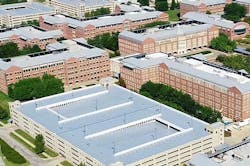Creative Reconstruction: KC's Aspiria Campus Embraces Energy Efficiency in Sprint to Decarbonized Future
Creative destruction is a catchphrase now in vogue within the business sector. It’s a term for innovation that might kill a legacy line of businesses but create other vibrant endeavors.
In the location that now houses the sprawling Aspiria office complex in the Kansas City metro suburb of Overland Park, Kansas, perhaps “creative reconstruction” might be an apt description for the complete overhaul which has taken place on the 200-acre campus. Once known as the Sprint World Headquarters housing the mobile firm’s corporate center, it is now home to small startups, remote workspaces, and major industrial leaders from multiple sectors.
The property also benefits from cutting-edge equipment and digital transformation work done with C&C Group, the Kansas-based contractor which is certified as “EcoXpert” on Schneider Electric’s EcoStruxure suite of products revolving around energy efficiency and analysis tools, including EcoStruxure Building Advisor services, EcoStruxure Power Operation and EcoStruxure Power Monitoring Expert.
The upgrades on building control, efficiency and comfort technologies have driven a 16% reduction in annual energy consumption, which translates to more than $1.5 million per year in energy cost savings.
“Our impact on the campus’ energy goals is coming from installed hardware and software,” Danny Davies, President of C&C Group, said in response to questions from EnergyTech. “The hardware components are the peripheral devices for the building automation system (such as HVAC controls) and the metering for the power side of the infrastructure.
“The software brings all of this data to one location and then analyzes, prioritizes, and proactively makes decisions in the best interest of energy consumption, occupant comfort, and, of course, safety,” Davies added.
Aspiria has a relatively short but storied, colorful, and resilient history. Sprint Corp., the then-rising mobile phone firm, was growing fast and needed to consolidate its far-flung headquarters within the Kansas City metro area. Company planners opted for a suburban campus-like setting dotted by hundreds of offices accommodating thousands of employees, including those from other tenants who subleased property there. Tenants include Black & Veatch, TreviPay, and others, according to reports.
Millions of square feet of available office space can be considered both a luxury and a burden. The COVID pandemic hit all commercial real estate hard, and keeping those spaces comfortable is a major expense.
Several years ago, the tenancy prospects for Sprint World Headquarters dropped considerably when its merger with T-Mobile was announced. T-Mobile is still a tenant there but not a namesake property owner. Instead, Sprint sold the campus to Occidental Management in 2019. The new owners and T-Mobile both contributed to building updates in the facility, which was renamed Aspiria in 2021.
“As you can imagine, managing over four million square feet, 20 buildings spanning across 200 acres, and more than 20 separate tenants can be extremely difficult,” C&C Group’s Davies said. “Since we completed the project in 2019, we’ve had 0% downtime for any major building equipment and a 65% reduction in temperature calls from occupants.”
The Aspiria carbon footprint was also reduced by nearly 36% compared with its earlier Sprint days.
ExoStruxure provides digital analysis and controls to make sure energy supply and demand are matched, working with efficiency upgrades to lower the consumption pattern. In this way, hardware and software work together.
“We have also retrofitted most of the campus interior and exterior lighting with LED technology, which has decreased our lighting energy to one-third of what it was when we purchased the campus,” said Gary Schlotzhauer, Aspiria’s Campus Director of Engineering. “We have also made significant energy reductions through chiller optimization and building operating parameters.”
Aspiria’s power purchase deal with Kansas City-based utility Evergy pays for about 89 million kWh of utility-scale renewable energy generated per year, although the campus uses perhaps 76 million KWh, providing a net carbon reduction.
Creative reconstruction is not the only catchphrase applied here. In Net Zero savvy circles, energy efficiency is often called “the first fuel” in decarbonization efforts. The MW you don’t use is MW saved and the CO2 not emitted, after all.
Building automation and bolted-on analytics, as C&C’s Davies calls them, balances the comfort need with sustainability goals to an almost even keel. And other property owners are noticing.
“In this area of the country, the Aspiria project has inspired other companies to seek similar strategies,” Davies pointed out. “We’ve hosted multiple site visits, presentations, and proposals to implement projects focused on reducing carbon footprint and sustainability.”
Creative imitation, perhaps.
Track News about the C&I Energy Transition Worldwide. Subscribe to the free EnergyTech Newsletter
About the Author
Rod Walton, EnergyTech Managing Editor
Managing Editor
For EnergyTech editorial inquiries, please contact Managing Editor Rod Walton at [email protected].
Rod Walton has spent 17 years covering the energy industry as a newspaper and trade journalist. He formerly was energy writer and business editor at the Tulsa World. Later, he spent six years covering the electricity power sector for Pennwell and Clarion Events. He joined Endeavor and EnergyTech in November 2021.
Walton earned his Bachelors degree in journalism from the University of Oklahoma. His career stops include the Moore American, Bartlesville Examiner-Enterprise, Wagoner Tribune and Tulsa World.
EnergyTech is focused on the mission critical and large-scale energy users and their sustainability and resiliency goals. These include the commercial and industrial sectors, as well as the military, universities, data centers and microgrids. The C&I sectors together account for close to 30 percent of greenhouse gas emissions in the U.S.
He was named Managing Editor for Microgrid Knowledge and EnergyTech starting July 1, 2023
Many large-scale energy users such as Fortune 500 companies, and mission-critical users such as military bases, universities, healthcare facilities, public safety and data centers, shifting their energy priorities to reach net-zero carbon goals within the coming decades. These include plans for renewable energy power purchase agreements, but also on-site resiliency projects such as microgrids, combined heat and power, rooftop solar, energy storage, digitalization and building efficiency upgrades.


